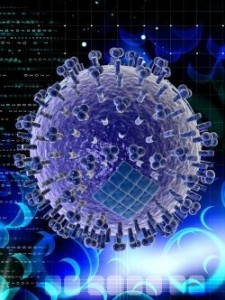 New research from Japan and China have confirmed that certain medicinal herbs and their constituents have the ability to directly inhibit influenza as well as stimulate the body’s own immune system in order to counteract the flu virus. The most recent finding is from China’s Northwest A&F University. Here researchers determined that two medicinal herbs known for clinical success in influenza treatment, and at least fifty phytochemicals contained in them, can inhibit the growth of the flu virus. The researchers tested two different herbs that are known in Chinese Medicine to inhibit viruses: Fructus forsythiae (also called Forsythia or Lian Qiao) and Lonicera japonica (also called Suikazura, Jinyinhua and Japanese Honeysuckle). The researchers exposed these herbs and their constituents to influenza viruses and human cells within a laboratory setting. The researchers found that these two herbs, and fifty of their constituents – phytochemicals that were isolated from them – significantly inhibited the replication of the viruses. The researchers’ findings have unveiled a new dimension among the phytochemicals that nature produces within certain medicinal herbs. This has to do with a two-pronged effect:
New research from Japan and China have confirmed that certain medicinal herbs and their constituents have the ability to directly inhibit influenza as well as stimulate the body’s own immune system in order to counteract the flu virus. The most recent finding is from China’s Northwest A&F University. Here researchers determined that two medicinal herbs known for clinical success in influenza treatment, and at least fifty phytochemicals contained in them, can inhibit the growth of the flu virus. The researchers tested two different herbs that are known in Chinese Medicine to inhibit viruses: Fructus forsythiae (also called Forsythia or Lian Qiao) and Lonicera japonica (also called Suikazura, Jinyinhua and Japanese Honeysuckle). The researchers exposed these herbs and their constituents to influenza viruses and human cells within a laboratory setting. The researchers found that these two herbs, and fifty of their constituents – phytochemicals that were isolated from them – significantly inhibited the replication of the viruses. The researchers’ findings have unveiled a new dimension among the phytochemicals that nature produces within certain medicinal herbs. This has to do with a two-pronged effect:
- The ability of these herbs and their phytochemicals to stimulate the body’s own immunity, allowing the body to be able to more effectively fight off the infection;
- The ability of the independent constituents within the herbal medicine to shut off a virus’ ability to replicate, even in a sterile environment outside the body.
The researchers concluded that “the overall data suggest that the medicinal herbs function by indirectly suppressing the virus proliferation via regulating the immune systems in hosts, and also, by directly inhibiting virus proliferation through targeting viral proteins essential for the viral life cycle.” Clinical research has supported these findings. In a clinical study from Japan’s Ohmura Hospital in Chiba, 150 patients with influenza A completed a study whereby the Japanese medicinal combination called Maoto was found to significantly reduce symptoms and influenza duration as compared to patients taking Oseltamivir or Zanamivir or patients not receiving any treatment. The research found that those patients given the Maoto had an average duration of 33 hours, versus 70 hours in the patients given no treatment, and 61 hours among those patients treated only with Oseltamivir. The marginally shortest flu duration was among those patients given both the Maoto and Oseltamivir, at 31 hours. The Japanese Maoto combination is composed of Ma Huang (Ephedra), Apricot Kernel, Cinnamon Bark and Licorice – also called Glycyrrhiza Root. Each of these herbs have been clinically utilized in different combinations by Traditional Chinese Medical doctors for stimulating immunity and inhibiting viruses. Another recent study, from Shandong University’s School of Pharmaceutical Sciences, has determined similar results with another plant, Polygonum nepalense (also called Napal smartweed). Polygonum nepalense is also known for effectively treating influenza. The researchers found that six polyphenols within the herbs – kaempferol, glucopyranoside, quercetin, pyrogallol, gallic acid and epipinoresinol – all effectively reduced infective inflammation. These herbs studied present only the tip of the iceberg among herbs that have been used among various traditional medicines around the world. There are a variety of herbs that are known to stimulate immunity, giving the immune system a stronger ability to fight off various infections. The U.S. influenza epidemic of 2013 has taken the lives of many, and hospitalized thousands. Most of those have been characterized as being immunosuppressed – their immune systems were weakened, either another infection or by a general lack of immunity. The role of herbs in this and any other epidemic is to stimulate the immune system to respond to these infective viruses. We add to this the Native American legend of Lomatium dissectum. According to the legend, Ernst Krebs, M.D. of Carson City observed that the Washoe Indians of Nevada seemed to recover quickly and avoid the plague of the 1918 influenza by taking an herbal medicine called “Toh-sa.” Dr. Krebs named it Balsamea, as it smelled like balsa. It was later named Leptotaenia dissecta and then Lomatium dissectum by botanists. Consistent with this legend, in 1995, the root of Lomatium dissectum was tested for antiviral activity at Canada’s University of British Columbia. The Lomatium was found to inhibit the “cytopathic effects” of rotavirus. Lomatium is only one herb from one traditional medicine among hundreds of herbs and hundreds of traditional medicines around the world. The effective inhibition of influenza by fifty constituents isolated from the two herbs in the new laboratory study from China illustrate that there are many anti-influenza herbal medicines, even besides the Maoto combination. Many of the fifty anti-influenza constituents found in Fructus forsythiae and Lonicera japonica also occur in other herbal medicines. In 2011, a Cochrane Review of Research from the Beijing University of Chinese Medicine found among 26 studies that several Chinese herbal medicines “demonstrated positive effect on fever resolution, relief of symptoms, and global effectiveness rate” for influenza. The research concluded, however, that more clinical research was necessary to confirm certainty. The two new studies from Japan and China considerably advance the level of certainty.
excerpted from:







